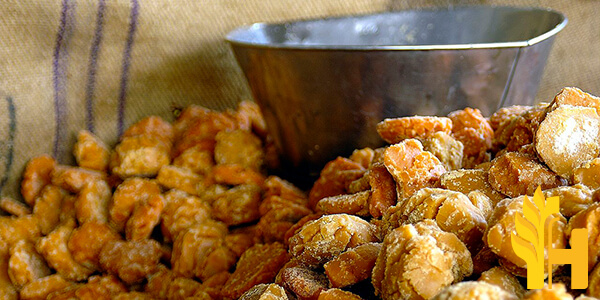Jaggery price

Where to buy and sell Jaggery, lowest (cheapest) and highest price.
check offers buy sell JaggeryToday price for JaggeryJaggery wholesale prices 2022
The Current commodity price of Jaggery per kg, pound in the world in the global markets
jaggery (گڑ)
Price range: 10250 - 11250 PKR / 100 kg | Market: Rahimyar Khan Market | Date: 2024-10-22
Jaggery
Jaggery, also known as gur or non-centrifugal sugar, is a type of natural product made of sugarcane. It is similar to sugar but occurs in a more unrefined form. It appears in a form of a raw brown mass of sucrose. The brown color is a result of other elements found in concentration, such as wood, ash, and bagasse. It is commonly made from sugar and date palm trees. The process of making jaggery is easier than making sugar, and the product itself is way healthier than refined sugar.It is mainly produced as an ingredient of sweet items but it is also consumed raw. Gur is also used in Ayurveda medicine recipes and in alcohol drinks-making such as palm wine. It is also an important product for the industrial production of chocolates, toffees, chewing gums, and many more sweets and candies. Gur is also used as a natural way of dying fabrics and when mixed with buttermilk and mustard oil used to season the inside of tandoor ovens. It is especially popular in Caribbean Islands, North Africa, Latin America, and southeast Asia, but the varieties of jaggery may differ as other ingredients are used in the process of making it.
The largest production of jaggery takes place in India where over 60% of the total global production takes place. Brazil is the largest exporter of gur. Other significant countries specialized in gur production are Malaysia, Japan, the USA, China, and Indonesia. India uses the most conventional methods to produce jaggery, as most of the manufacturing units are located in rural regions.
The largest number of jaggery manufacturing units is located in the Kushinagar district of Uttar Pradesh. The major producers in India are Maharashtra, Karnataka, Tamil Nadu, and UP. Although the production of jaggery is not very expensive, its storage is concerning. Gur is commonly used as a sweetener in India and it's often a substitute for sugar in rural India.
The overall price of jaggery depends on the price of sugarcane and many other factors such as government policies, demand, and supply.
Global jaggery production
Jaggery is a traditional non-centrifugal cane sugar consumed in Asia, Africa, and some countries in the Americas. It is a concentrated product of cane juice and often date or palm sap without separation of the molasses and crystals, and can vary from golden brown to dark brown in color. It contains up to 50% sucrose, up to 20% invert sugars, and up to 20% moisture. Jaggery is mixed with other ingredients such as peanuts and sesame seedss and forms a type of candy. In India, Pakistan, and Nepal, jaggery is made using sugarcane juice which is first boiled to form a syrup. The syrup is then allowed to cool and solidify. This process is repeated several times until the desired consistency is achieved. Once it has cooled and solidified, the jaggery is then cut into small pieces or grated. In 2014, jaggery production reached an estimated 1.3 million tonnes, with India and Pakistan accounting for approximately 60% of the world's total (table). Jaggery is a traditional non-centrifugal cane sugar consumed in Asia, Africa, and some countries in the Americas. It is a concentrated product of cane juice and often date or palm sap without separation of the molasses and crystals, and can vary from golden brown to dark brown in color. It has a pleasing taste due largely to the presence of sucrose and is used as either a sweetener or a substitute for white sugar. Jaggery is made of the products of sugarcane or the toddy palm tree. The sap of these trees is collected and the juice is extracted from it. This juice is then boiled to evaporate water. The syrup thus left behind is allowed to cool and solidify which results in the formation of jaggery. Jaggery can be either in the form of a block or in powders. It has a strong, pleasing smell and a brownish colour. It is made without the use of any chemicals or preservatives. Jaggery has many nutritional as well as medicinal benefits. It is a rich source of iron and therefore, consuming it regularly can help in treating anaemia.Download our new
Husfarm App
Stay up to date with the current prieces of agricultural products all over the world.
Do you want to sell agricultural products?
Are you an Agricultural processor looking for high-quality products to buy?
Post an ad for FREE!
